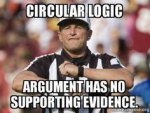I know you like to take things to extremes when speaking about what I said, but that doesn't serve the discussion at all Seebs.
Uh, what? I am not taking anything to extremes. I'm responding to what you said. Possibly not to what you meant, but I am not a mind reader.
You said: "Give me a rules quote that says you can interrupt actions." Well, I gave you two examples of explicit statements about things interrupting other things in the rules. So, actions can be interrupted. There you have it; you have rules quotes that state that you can interrupt actions.
Now, those don't directly state that you can interrupt things with a readied action, but it's important to note that the readied action rules don't say that they take effect after the action containing their trigger, but immediately after their trigger. Not after movement is complete, but after someone has fully moved to a particular location.
Especially when you're simply making strawmen to argue against. Counterspell, just like Shield specifically calls out that it can interrupt an action and invalidate it's own trigger. Shield an attack vs Counterspell is the casting of a spell. I still haven't seen anything more other than the examples which give no context or direction as to how to resolve the triggers in practice.
Okay, so think it through.
If you can't take your action immediately upon the cultist stepping on the trap door, but rather, you have to wait for the cultist's entire move to complete before pulling the lever... Does that do you any good at all? No! It's useless. And it would be an atrocious example to give, if it wouldn't actually usefully work, unless they were using the example to point out one of the limitations of readied actions.
So the fact that they don't tell you how it works suggests strongly that it works in the only useful way, which is to say, "the trap door opens before the cultist can continue moving".
Which is to say, it interrupts the move.
I see examples of perceivable events, which fall within DM fiat to allow in the first place. So I'm not convinced at all. Again you making strawmen to argue against doesn't make you right.
I'm not arguing against a strawman, I'm arguing for application of Gricean maxims to the text. They would not provide an example of a trigger unless they thought it ought to work and be a valid trigger that would be useful, or they were going to use it to illustrate the limits of readied actions. Since there's nothing explicitly saying what happens, and the text is completely useless if it isn't communicating something about their intent, we take the plain language reading that those triggers are expected to work. They are offered as examples of the kinds of triggers which are supposed to be usefully possible within the game. Sure, the DM has final say in what's allowed, but then, the DM is allowed to always refuse to allow any readied action. There's no rule that explicitly says that the DM must allow you to ready any specific action; the DM can just declare every suggested trigger to be disallowed. Discussion of a hypothetical hostile DM is uninteresting; we have to assume the DM is at least trying to create a game experience basically similar to what the designers suggest, and that means that these are examples of reasonable readied actions which the DM should allow and which should work in a useful manner.
EDIT: And looking at the 2 examples you listed, both involve movement and don't specify ongoing actions. A goblin moving next to someone and in response to that event a character moves away. The example allows for both interpretations, there's nothing stating the goblin was going to continue moving. Simply that he moved next to someone. The trap door is the same, pulling a lever when someone steps on a trap. No mention of moving beyond the trap door or an ongoing action, simply moving onto it. That allows again for BOTH interpretations to be true. So basically, even the examples can be shown to support both interpretations if you don't add biased context.
Which is to say, if you specifically drop the assumption that the people writing the book put them there with any intent that they communicate anything about the game... But even then, they don't support both interpretations, they are merely consistent with both interpretations. But if we assume that the writers intended that text to mean something, or to tell us anything about the game, they tell us that a readied action can occur during someone else's move.
What we need for example is a rules quote that says reactions can interrupt ongoing actions, like going off mid movement or between attacks. Or a dev tweet which supports either side. AFAIK there is no rules quote available to support the interruption of actions with reactions beyond specific reactions that specifically state that they do. IE: Shield, Counterspell, Opportunity Attacks. I would also say that I find it odd that these reactions need to specifically call out that they can interrupt actions the way they do while you're assuming all reactions can, even without rules text to support that claim. But let's stick to the first points since it'll answer this one too.
You haven't understood my position. I don't think a readied action can in general interrupt the casting of a "1 action" spell, because if the casting is the trigger, the trigger completes before the reaction takes place. So that won't work. But if you can pull a lever the moment someone steps on a trap door, and movement can happen between attacks, then you can pull a lever if someone steps on a trap door while moving between attacks. Becaus the "trigger" is not necessarily the same thing as "the entire action which contains the trigger".
The reason opportunity attacks need special language is that they are doing something unusual: They are activating before their trigger completes, because if they went off after it completed, they would always fail because the target would be out of range. (Presumably, it works the other way with the opportunity attacks granted by polearm master, or else they'd never be able to hit because the target would be out of range.) But the thing that makes them unusual isn't "reaction happens before enemy's entire 30 foot move is done", but "reaction happens before the 5 foot move which triggered it is done".






